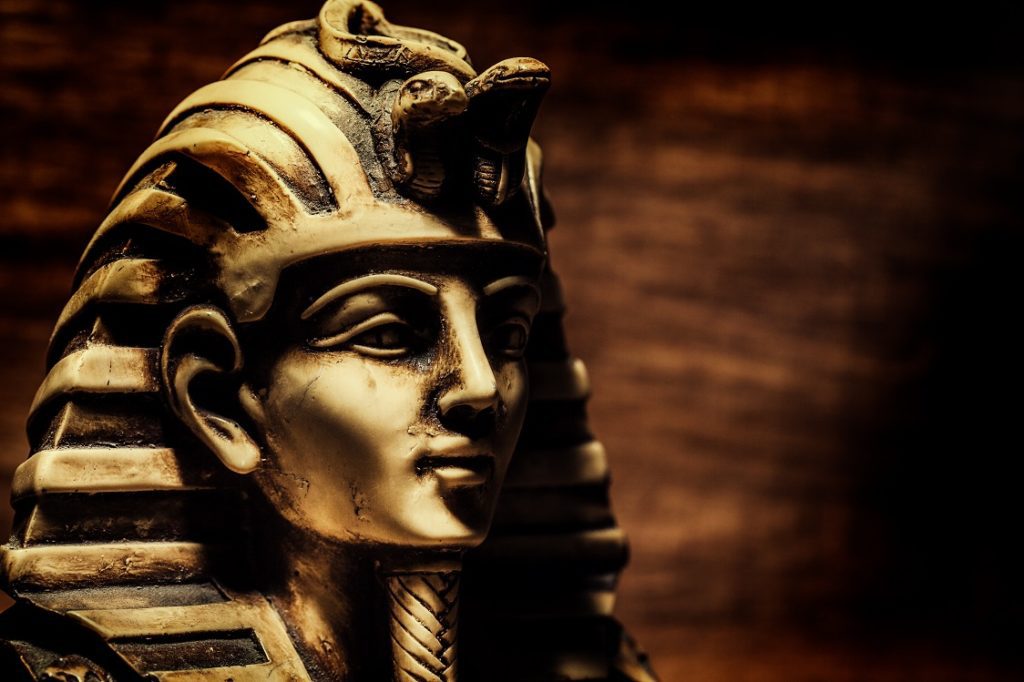Curses have been around for as long as human beings have held belief in and pondered the supernatural world. Vengeful gods and maligned spirits have been summoned throughout human history to inflict misfortune upon the recipient.
You can find evidence of people using curses to ward off wrongdoers and impose retribution for bad acts as far back as the ancient Sumerian culture some 6000 years ago. Archaeologists found curses carved into the walls of the great Pharaohs’ tombs to deter would-be thieves. Religious texts from the Bible to the Hindu Vedas and the Koran all have accounts of curses.
Looking through the landscape of human civilization, curses can be found throughout myriad cultures and epochs. In the end, they share a common theme of causing misfortune from beyond the material realm to an unlucky soul.
Table of Contents
Famous Ancient Curses
Famous ancient curses appear in texts from ancient Egypt, Europe, and India.
1. Tutankhamun
Discovered in 1923 by archaeologist Howard Carter, Tutankhamun’s tomb was an instant sensation, as it was completely undisturbed and still filled with all the treasures and surroundings of a Pharaoh’s burial. Unfortunately, that also meant that they were the first to transgress the site.
Indeed, over the ensuing years, a number of Carter’s excavation team suffered misfortune, including death, fires, and floods. Many people speculated that these misfortunes were the result of the mummy’s curse.
2. The Bjorketorp Runestone
Scandinavia is home to a number of historic runestones that have engraved upon them many different texts, some of which include curses.
Perhaps the most famous of these is the Bjorketorp Runestone in Sweden. The Bjorketorp runestone was erected sometime in the 6th century ACE and measures almost 14 feet in height.
On one side of the rune is transcribed the phrase, “I see Perdition.” On the other side is a transcription that speaks to the power of the creator of the rune. It indicates that anyone who disturbs or breaks the runestone will be cursed to insidious death and destruction.
The runestone still stands intact, so the veracity of this curse remains to be proven.
3. Shivas Curse Upon Brahma
According to ancient Hindu texts probably from the fourth century, Brahma and Vishnu had an argument about which deity was more powerful. During this disagreement, a giant Shiva Linga appeared. Shiva then asked the two deities to measure the true length of the Linga, and whoever could do this the quickest would be proclaimed the superior of the two.
Vishnu immediately understood that this was a test by the most powerful Shiva, as his might and omnipotence could never be measured. However, Brahma, desperate to prove his primacy over Vishnu, lied to Shiva. He proclaimed that he had found both ends of the Linga.
Because of this lie, Shiva cursed him that no one would worship him. To this day, there are no Hindu holidays to celebrate Brahma.
4. The Curse of the Knights Templar
Everyone knows about the superstition about Friday the 13th being unlucky, but few know where this actually originates.
In the early 14th century, Ing Philip of France was displeased with the Knights Templar funding his war against the English and did not want to pay it back. So on Friday, October 13, 1307, King Philip, in collusion with Pope Clement V, launched a surprise attack, bringing about their ultimate destruction.
However, the king did not escape retribution. Jacques de Molay, the leader of the Knights, was imprisoned and tortured over the course of seven years and ultimately burned at the stake. Before his public execution, de Molay cursed the King and the Pope to die quickly and further cursed the House of Capet family to destruction.
Sure enough, within a year, both Pope Clement V and King Philip had both died mysteriously. Furthermore, all 3 of King Philip’s sons died within the next few years, as did his only male grandchild. As a result of that, the French crown went to the House Valois, bringing an end to the reign of House Capet.
To this day, Friday the 13th is still considered an unlucky day.
Ancient Latin Curses
Latin America has its fair share of curses to explore.
1. Mal de Ojo of Mexico
The Mal de Ojo, or Evil Eye, is one of the most ubiquitous curses throughout Latin American culture and all human history. Its origins have been traced back to ancient Greece, Rome, and the Mediterranean, with some symbols going back as far as 1500 BC in the Mediterranean.
The curse of the Mal de Ojo is said to bring back luck or even bodily harm to those upon whom the gaze is cast. The curse can be intentional, as in concentrating negative thoughts and energies toward a person. However, in Latin culture, it is believed that the evil eye can also be cast unintentionally, particularly toward beautiful children.
The belief is that if someone looks upon a beautiful child with envy or wantonness, it will result in the child becoming sick or injured. To remedy this curse, folklore has come up with many rituals, including touching the child quickly after the stare, rubbing an egg around the head to absorb the bad energy, and wearing any number of talismans to ward off the evil intent.
2. Santeria Curses
Santeria is a belief system that borrows from Afro-Cuban and Catholic traditions. It focuses on bridging the divide between the physical world of people and the spiritual world of Orishas. These spiritual beings can bestow blessings and curses alike through rituals performed at altars, which are thought to create a portal between the two realms.
Practitioners of Santeria employ dances, blood rituals, and sacrificial animal rituals to commune with their spirit guides and request their assistance and guidance. Although many practitioners say that these practices are done only for the benefit of the community, others believe that curses are also used to exact retribution or to right a perceived wrongdoing.
3. La Llorona
The origins of the curse of La Llorona are said to go back hundreds of years into Spanish folklore.
The most common telling of the story speaks of a beautiful and vain woman named Maria who marries a rich man but does not truly love him. Still, they have two children together.
Over the next few years, their marriage deteriorates, having been a union of greed and vanity, and not love. One day, Maria sees her husband and children out with another woman. Exploding with rage, Maria grabs her two children and throws them into the river and to their deaths.
Overtaken with grief, she then drowns herself in the same river. However, because of her evil deed, she is cursed to spend eternity haunting the banks of rivers and lakes searching for her dead children. Some say that you can hear her wailing in the night, and if you do not run away, she will take your life. The wailings are often said to be aimed at children or cheating husbands in various tellings.
Ancient Roman Curses
Several curses were a part of life during ancient Rome’s existence from 625 BC to 476 AD.
1. Broken Mirror Curse
Almost everyone has heard that breaking a mirror dooms you to seven years of bad luck.
This curse has its origins in Ancient Rome. The Romans believed that the human soul would renew every seven years, repairing whatever damage they had suffered during that time. They also thought that a mirror’s reflection was a way to look into the soul.
If you break a mirror, you break apart your soul, which would have to go through a 7-year cycle to renew. Until your soul achieves renewal, you would endure misfortune because of your broken soul.
2. Roman Curse Tablets
Romans used lead tablets inscribed with a variety of curses in a number of ways in ancient Rome.
One of their uses was to elicit help from the dead. Many Roman graves contain these tablets. Usually, they were asking for help from a particular deity to get revenge on someone by having that deity bestow malfeasance or misfortune upon them. In return, the person writing the message would promise to make offerings at their temple.
Romans would bury these tablets in front of thresholds or upon trees outside of homes to bestow the curses. They thought that being in proximity to the targets’ homes would help bring the gods to them to make it easier to curse them. It was also common to place a curse tablet in a body of water.
3. Curse Dolls
Much like the infamous Voodoo dolls, ancient Romans would use miniature dolls as effigies of their targets to instill curses upon them. They sometimes used curse dolls in conjunction with a curse tablet, and other times used dolls by themselves. The dolls were generally lead or bronze.
In order to be an effective curse doll, it had to meet certain criteria:
- The doll contained the target’s name.
- The doll’s arms and legs were twisted behind the torso.
- The doll was skewered with nails.
- The head or feet were backward.
- It was placed in a grave, buried near the target’s home or in a body of water.
Curse dolls served the same purpose as curse tablets, but would not always employ explicit directions or be addressed to a particular deity.
4: Dido’s Curse upon Troy
From Rome’s storied mythological heroes, the curse on Aeneas by his once-lover Dido is one of the most famous in Roman lore.
According to legend, Aeneas was the son of the Trojan prince Anchises and the goddess Venus. He was a legendary hero of the Trojan war as well as an ancestor of Romulus and Remus, the founders of Rome. He is considered the first true hero of Roman folklore.
After the fall of Troy around 1180 BC, Aeneas wandered for a period before finding a safe harbor in Carthage, where he wed Dido, the queen of Carthage. She proposed the marriage so that they may reign over all the territory jointly. However, the arrangement was under false pretenses, and at the urging of his mother Venus, Aeneas and his company stole away in the night.
Dido was so enraged by the betrayal that she uttered a curse that Troy and Carthage would forever be enemies, which eventually led to the Punic Wars.
Curses in the Bible
Curses in the Bible were visited upon the Hebrew people and generally relate to a person’s or group’s relationship with God. The Old Testament portions of the Bible that contain these curses were written at different times between 1200 and 165 BC.
1. The Curse of Cain
One of the more well-known stories of the Bible is the murder of Abel by his brother Cain. Cain and Abel were the first two sons born to the first humans, Adam and Eve. Both Cain and Abel made offerings to God. However, Cain became jealous of his brother when God seemed to favor Abel’s offerings, and so he murdered his brother. To make matters worse, he lied about it to God.
God, being all-knowing, knew that Cain had lied, and so he put a curse upon Cain that all land he tried to sow would be fallow. As a result, he could no longer grow crops and was banished to wander in the land of Nod until he finally built the city of Enoch, named after his firstborn son.
Cain is said to have ended the age of innocence of humans through his wicked deeds and deceit. Some Biblical scholars argue that this curse lives within all people to this day.
2. The Curse of Ham
One of the more controversial and odd curses in the Bible comes from a story about Noah and his sons.
In the story, Noah had settled down and had a vineyard, where he made and drank wine. One evening Noah’s son Ham happened upon his father who was drunk, naked, and passed out in his tent. Ham told his Brother Japheth about this, causing Japheth to go in and cover his father in robes without gazing upon his nakedness.
When Noah found out about all this, He cursed Ham’s son Canaan and all his followers and descendants to be subjugated as slaves to the Israelites.
People later used the story of the curse of Ham to justify segregation and slavery because Ham was portrayed as being black. It stands as one of the more well-known curses from the Bible.
3. Bethsaida, Korazim, and Capernaum
According to the Bible, these three cities are where Jesus performed many of his miracles. These three cities beside the Sea of Galilee were paganistic and did not repent their ways, even after the miracles performed there.
Jesus then admonished them for their lack of faith and decried that they would suffer mightily on the day of Judgement. He proclaimed that these three cities would not ascend into heaven but instead fall into the depths of hell.
4. The Curse of Sodom and Gomorrah
To be out of the graces of God through sinful behavior is essentially to be cursed. The tale of Sodom and Gomorrah is a perfect example of this.
The two cities were bastions of sinful behavior despite the word of God. Angels went to see what was going on and were beaten and accosted by the people of the cities.
Because of their wickedness, God rained down fire and sulfur upon them and destroyed them as punishment and to serve as a warning to others to obey the word of God.
Final Thoughts on Curses
While some ancient curses pass into oblivion, others remain with us in the present epoch. You’ve probably heard that Friday the 13th and breaking a mirror are unlucky, but perhaps you didn’t know the origin. Curses related to religion, such as the curse of Cain may be familiar. And even cultural outsiders will recognize La Llorona and the Curse of Tutankhamun. Some of today’s wrongdoers are still wary of misfortunes that could befall them from curses of old.











